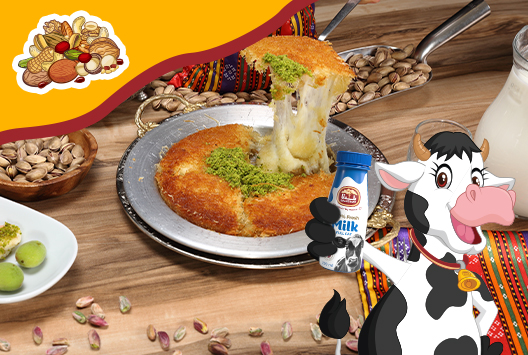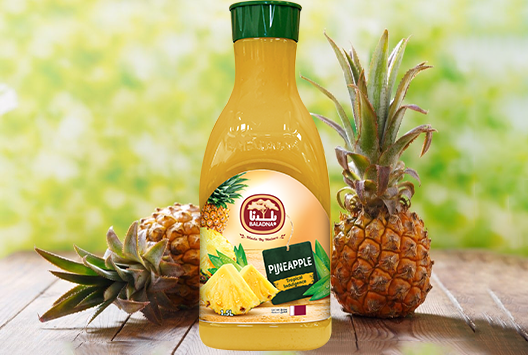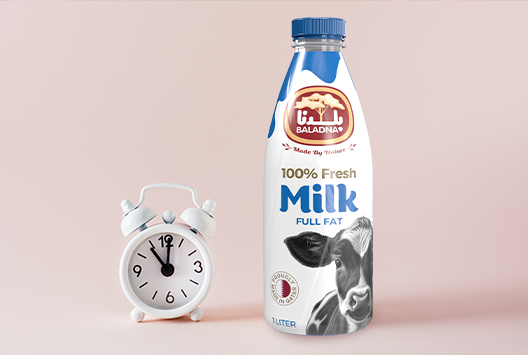- Home
- Blog
Latest Articles

Baladna Back to School Song Lyrics – Unity & Inspiration
The day awakens, and together we rise,ابتدى الصبح وقعدنا .. كلنا من النوم The sun spills joy across a world prepared.واشرقت شمس السعادة وكل شي جاهز When Mila arrives, our faces bloom with smiles,من تجي ( ميلا ) ابتسمنا للحياة كل يوم،Her touch is magic, her spirit a gentle flame that carries us forward.عندنا ( ميلا ) وسحرها وهي لنا حافز Our Baladna, we all walk together,بلدنا .. لا مشينا كلنا .. On every path we take to school each day, each day. بكل طريق نسلكه للدراسة كل يوم كل يوم.. Our Baladna, we all rejoice together, بلدنا .. لا فرحنا كلنا ..In every success we achieve in our studies each day. each day.بكل نجاح نكسبه فالدراسة كل يوم كل يوم
Recent Articles

Bring Out The Child In You: Qatari-Inspired Dairy Desserts
Everybody loves diving into sweet indulgence, especially when it involves the nostalgic flavors of childhood desserts, but have you ever imagined re-creating those moments with a dash of Qatari tradition? Well, it’s time to embark on a playful journey featuring Baladna’s dairy products. This is a world where cherished childhood memories meet the rich flavors of Baladna's dairy delights. Join us on a journey filled with delightful dessert recipes, and let your creativity run wild as you put these treats together. Ready? Let’s go! 1. Sweet Dreamboats: Baladna Milk Pudding with Qatari DatesGet ready to enjoy this Qatari-infused milk pudding, a soothing treat that captures the essence of traditional flavors. Create this dessert by combining Baladna's fresh milk, sugar, cornstarch, and a touch of rose water or orange blossom water. Finish it off with a sprinkle of soft dates and a drizzle of honey. With each spoonful of this creamy pudding, let yourself reminisce about Qatar's date palm trees and the playful moments of the past.2. Cool Down and Crunch: Baladna Labneh and Berry Frozen CupsEscape the Qatari heat with a cooling and nostalgic treat. These Baladna Labneh and Berry Frozen Cups are the perfect fusion of creamy labneh and frozen berries. Simply blend Baladna Labneh, your preferred berries, and a touch of honey or maple syrup for sweetness. Pour into cups, insert wooden sticks, and freeze. These frozen delights will remind you of the joy of sharing icy treats on sunny days.3. Nutty Nirvana: Baladna Balaleet-inspired Bread PuddingExplore a world of flavors with Baladna's Balaleet-inspired Bread Pudding. Start by soaking stale bread cubes in a mix of Baladna milk, fragrant spices like cardamom and cinnamon, and a touch of saffron-infused water. Layer the blend into a baking dish with nuts, raisins, and vermicelli. Place in the oven until golden and savor the blend of tradition and comforting memories in every bite. 4. Raise the Dough: Baladna Yoghurt Chapati S'moresWhy save s'mores just for camping? Try out this Baladna Yoghurt Chapati S'mores twist. Create soft chapati dough using Baladna yoghurt and flour, then cook until golden. After cooling, make a sandwich with your preferred chocolate and marshmallows. Bake until the ingredients meld together, creating a delightful treat. This creative take on s'mores is sure to become a cherished choice in your home. Every bite is a taste of nostalgia As you embark on this dessert journey, enjoy the taste of nostalgia in every bite. These delicious treats celebrate the connection between Baladna dairy, nostalgic flavors, and Qatari culture. It’s time to indulge, taste, and let the sweetness of Baladna dairy elevate your dessert experience. Shop our products today and experience the distinctive flavor first-hand.

Here Are 4 Reasons Why Dairy Is Good for You
Are you ready to dive into the deliciously nutritious world of dairy? Get your spoons and straws ready because we are about to embark on a tour of the health benefits that dairy has to offer. From yoghurt and ayran to milk and cheese, there's a whole barn-load of goodness that we often take for granted. So why don't you join us as we milk this topic for all it's worth, and uncover the secrets that make dairy products not just tasty, but amazing for our health too!1. Calcium: The ultimate cheerleader for your bones You've probably heard it a thousand times before, but we'll say it again: calcium is vital for strong bones and teeth. And when it comes to calcium, dairy is the MVP. A single glass of milk contains around 300 mg of calcium, which is about one-third of an adult's daily requirement. Say goodbye to brittle bones and hello to a stronger, more robust skeleton. Plus, the calcium in dairy products is easily absorbed by the body, so you can be sure that your bones are reaping the full benefits. Remember the old saying, "milk does a body good”? Turns out it's true!2. Protein: The whey to go for muscle growth and repairDairy products aren't just good for your bones; they are also packed with high-quality protein. This macronutrient is essential for muscle growth, repair, and maintenance, as well as keeping your hair, nails, and skin looking fabulous. Milk, cheese, and yoghurt all contain a good amount of protein, but Greek yoghurt and cottage cheese are particularly protein-rich options. And if you've been hitting the gym, you've probably heard about the wonders of whey protein. This fast-absorbing protein, derived from milk, can help you build muscle, lose fat, and improve your athletic performance. 3. Probiotics: The gut-feeling you can trust If you're looking for a gut-friendly food, look no further than fermented dairy products like yoghurt and kefir. These delightful treats are packed with live bacteria and yeast, aka probiotics, which are essential for maintaining a healthy gut microbiome. Probiotics can help with digestion, boost your immune system, and even improve your mood (yes, that's right—a happy belly equals a happy mind). So, don't be sour, embrace the probiotic power of dairy and watch your gut health flourish.4. Overall improvement in healthThe health benefits of dairy don't stop at calcium, protein, and probiotics. Consuming dairy products can help lower your risk of developing heart disease, type 2 diabetes, and high blood pressure. Plus, dairy has been linked to improved weight management and a reduced risk of obesity. And for those who are lactose intolerant, don't worry, there are plenty of lactose-free dairy options available, so you can still reap the rewards of this nutritious food group.

Power Hour: The Best Time To Drink Pineapple Juice
Pineapple juice is a delicious and refreshing drink that is enjoyed by people all over the world. It is made from the fruit of the pineapple plant, which is native to South America but is now grown in many parts of the world. But, did you know that pineapple juice is like a superhero drink packed with vitamins, minerals, and antioxidants? That's right! It's like having a powerful elixir that can provide numerous health benefits to your body and mind. In this article, we will take a closer look at the health benefits of pineapple juice. We’ll also explore the best time to drink it. Pineapple Juice: A look at calories and nutrition factsA 100 ml bottle of Baladna Pineapple Juice contains around 46.1 calories, which makes it a relatively low-calorie drink. It is also packed with vitamins and minerals. In fact, one cup of pineapple juice can help you achieve your recommended vitamin C intake. It is also a good source of vitamin B6, thiamin, and folate. Did you know that pineapple juice is also good for your heart health? It's true! This power drink is packed with potassium, which can help regulate blood pressure and promote a healthy heart. Plus, it's got a few other sidekicks like calcium, magnesium, and iron that can help keep your body strong and healthy. When is the best time to drink pineapple juice?There is no one right answer to this question. The ideal time to drink pineapple juice depends on your preferences and lifestyle. But, here are some guidelines to help you maximize the benefits of pineapple juice: In the morningDo you need help to get your day started? Grab a glass of pineapple juice and get ready to feel energized! Pineapple juice is the perfect way to kickstart your metabolism and give you a natural boost of energy. What’s more – it's packed with vitamin C, like a superhero that fights off bad guys (aka free radicals) and boosts your immune system. And get this, vitamin C also helps your body absorb iron, which is super important for keeping your blood cells healthy.But wait, there's even more! Drinking pineapple juice in the morning on an empty stomach can help your tummy too. It helps break down proteins, making you feel less bloated and more comfortable. So go ahead, pour yourself a glass of pineapple juice in the morning and get ready to take on the day!Before or after exerciseAre you seeking a secret weapon to take your workouts to the next level? Look no further than pineapple juice! This tasty drink can help improve your athletic performance and aid muscle recovery. Pineapple juice contains potassium, which works wonders for your muscles. It helps regulate fluid balance and prevents pesky muscle cramps from ruining your workout. It also provides a quick burst of energy, perfect for powering you up before a workout.But the magic of pineapple juice doesn't stop there. After a tough workout, drinking pineapple juice can help reduce inflammation and aid in muscle recovery. This is all thanks to the bromelain enzyme in pineapple. It helps fight off soreness in your muscles, so you can recover faster and get back to crushing your workouts.Before a mealDrinking pineapple juice before a healthy feast can help stimulate digestion and reduce your appetite. Pineapple juice is packed with fiber, which can help regulate your digestive system and promote feelings of fullness.Drinking pineapple juice before a meal can also help reduce cravings for unhealthy snacks and promote weight loss. The natural sugars in pineapple juice provide a quick energy boost, which can help curb cravings for sugary or fatty foods. Before bedAre you having trouble catching a proper good night's sleep? Well, pineapple juice will certainly help you drift off to dreamland. That is because pineapple contains an amino acid called tryptophan, which is like a sidekick to serotonin – the neurotransmitter that helps regulate mood and promote feelings of relaxation. This means no more tossing and turning as you try to get comfortable! But, if you're sensitive to acidic foods, you may want to skip this drink before bedtime.Go ahead and pour yourself a glass of pineapple juice! Are you looking for a fun and delicious way to boost your health? Well, look no further because Baladna Pineapple Juice is here to save the day! Get yourself some pineapple juice today; your taste buds and body will thank you!

When Is The Best Time To Drink Milk? And What Are The Benefits?
While milk can be consumed at any time of the day, drinking milk at night can have several benefits. Drinking milk at night has been a long-standing tradition in many cultures for centuries. While some may argue that it’s an old wives’ tale, scientific evidence supports the benefits of drinking milk at night. Here are some ways drinking milk at night can improve health.1. Helps people fall asleep fasterMilk contains tryptophan, an amino acid converted into serotonin and melatonin in the brain. Serotonin is a neurotransmitter that helps regulate mood, while melatonin is a hormone that helps regulate sleep. By drinking milk before bed, people can increase the levels of these chemicals in their brains, which can help them fall asleep faster.2. Promotes healthier sleep cyclesIn addition to helping people fall asleep faster, drinking milk at night can promote healthier sleep cycles. Milk contains calcium, which helps regulate the production of melatonin. By consuming milk before bed, people can help regulate their sleep cycles, leading to better quality sleep.3. Improves psychological healthDrinking warm milk before bed can also have psychological benefits. The warmth and comfort of the milk can help people feel relaxed and calm, reducing stress and anxiety. Additionally, drinking warm milk before bed can become a comforting bedtime routine, improving overall psychological well-being.Warm vs. Cold MilkMilk is a staple in many diets and is an excellent source of essential nutrients such as calcium, vitamin D, and protein. It is consumed in many forms, including as a beverage, in recipes, and as a supplement. Meanwhile, milk's nutrient content remains the same regardless of temperature. Some differences exist between warm and cold milk.Warm MilkDrinking warm milk can have a soothing effect on the body, helping to promote relaxation and improve sleep. Warm milk can also help improve digestion and promote healthy bowel movements. Additionally, warm milk can be a comforting bedtime routine, enhancing psychological well-being.One reason is that milk contains an amino acid called tryptophan, a precursor to the neurotransmitter serotonin. Serotonin is a chemical that helps regulate mood, appetite, and sleep. When you consume tryptophan, your body converts it into serotonin, which can help promote calmness and relaxation.Cold MilkCold milk can refresh the body, making it an excellent option for hot summer days. Cold milk can also be used in smoothies or other cold beverages, making it a versatile ingredient. Additionally, cold milk can be an excellent post-workout beverage, as it can help replenish the body's fluids and nutrients.Cold milk can also be used in smoothies or other cold beverages. It is a versatile ingredient that can be combined with fruits, nuts, and other ingredients to create unique and delicious drinks. Smoothies made with cold milk are an excellent way to get a healthy dose of nutrients while also enjoying a tasty and refreshing drink.

Mila’s Weekly Routine Tracker
Keep mornings and evenings on track with Mila’s weekly routine chart. Kids can write down their tasks, check them off each day, and celebrate their progress. It’s a fun way to build healthy habits and stay motivated all week long

Mila’s School Prep Checklist
Start every school day prepared and stress free. Mila’s checklist helps families organize supplies, clothing, and food so nothing is forgotten in the morning rush. From notebooks to uniforms to a healthy snack with Baladna milk, everything your child needs is covered